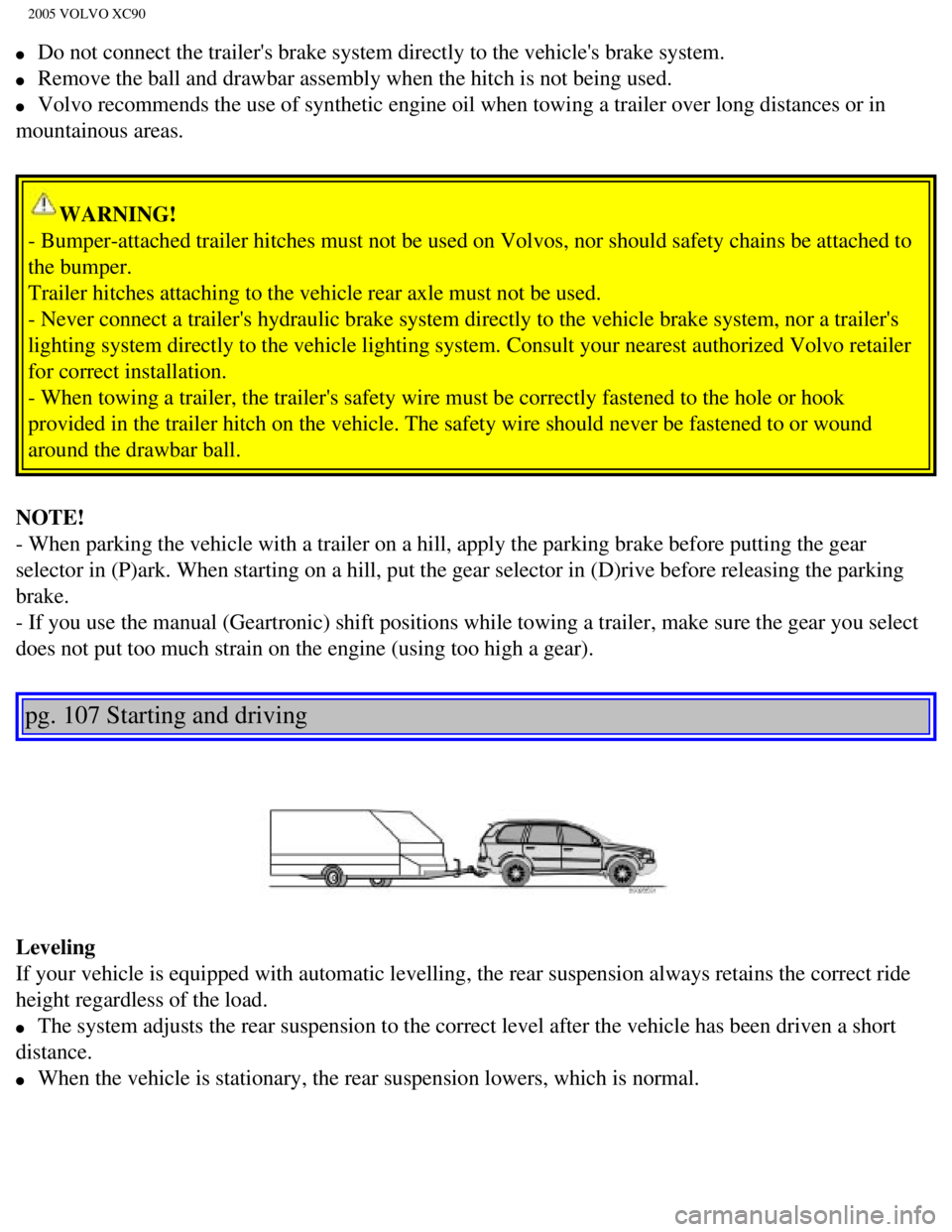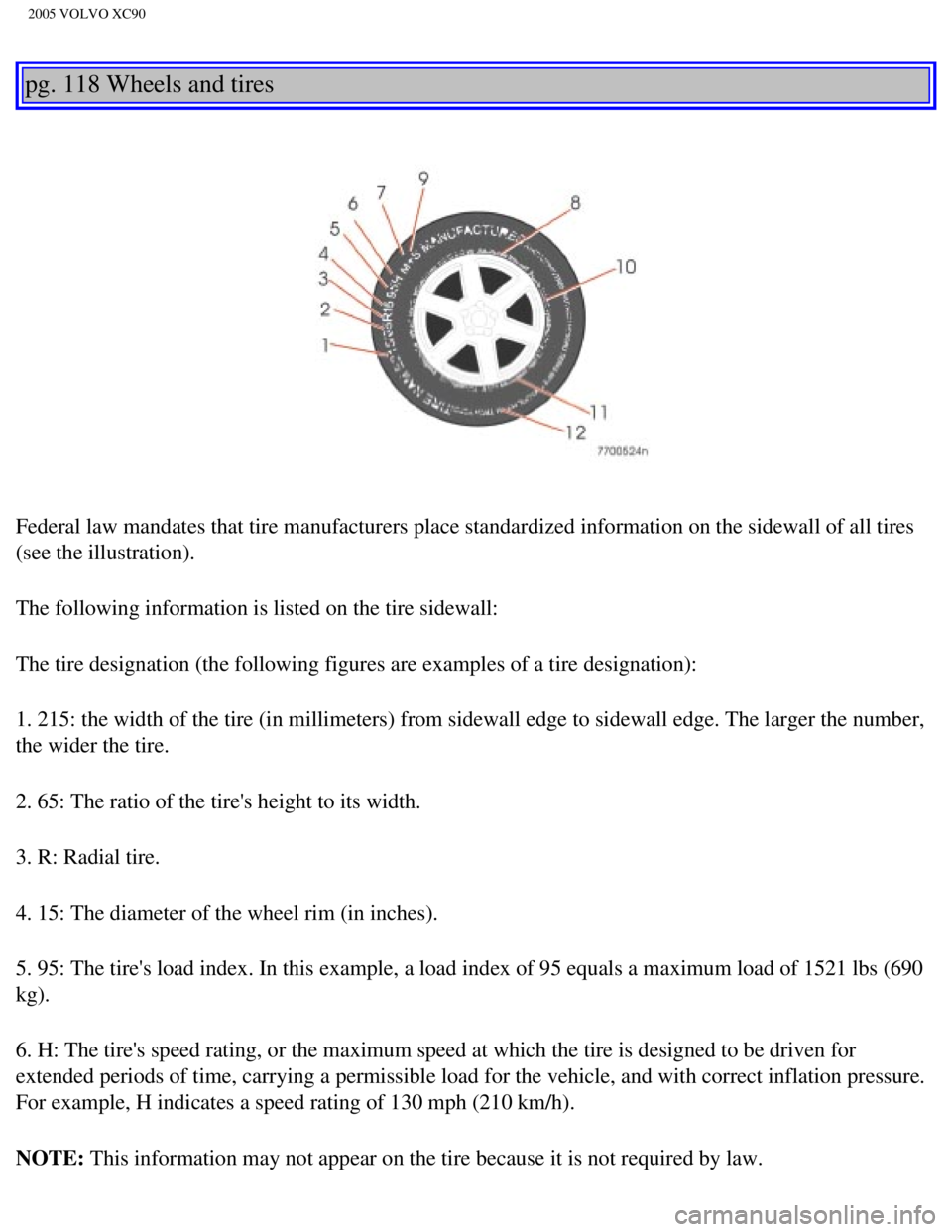Page 143 of 263

2005 VOLVO XC90
l Do not connect the trailer's brake system directly to the vehicle's brak\
e system.
l Remove the ball and drawbar assembly when the hitch is not being used.
l Volvo recommends the use of synthetic engine oil when towing a trailer o\
ver long distances or in
mountainous areas.
WARNING!
- Bumper-attached trailer hitches must not be used on Volvos, nor should\
safety chains be attached to
the bumper.
Trailer hitches attaching to the vehicle rear axle must not be used.
- Never connect a trailer's hydraulic brake system directly to the vehic\
le brake system, nor a trailer's
lighting system directly to the vehicle lighting system. Consult your ne\
arest authorized Volvo retailer
for correct installation.
- When towing a trailer, the trailer's safety wire must be correctly fas\
tened to the hole or hook
provided in the trailer hitch on the vehicle. The safety wire should nev\
er be fastened to or wound
around the drawbar ball.
NOTE!
- When parking the vehicle with a trailer on a hill, apply the parking b\
rake before putting the gear
selector in (P)ark. When starting on a hill, put the gear selector in \
(D)rive before releasing the parking
brake.
- If you use the manual (Geartronic) shift positions while towing a tr\
ailer, make sure the gear you select
does not put too much strain on the engine (using too high a gear).
pg. 107 Starting and driving
Leveling
If your vehicle is equipped with automatic levelling, the rear suspensio\
n always retains the correct ride
height regardless of the load.
l The system adjusts the rear suspension to the correct level after the ve\
hicle has been driven a short
distance.
l When the vehicle is stationary, the rear suspension lowers, which is nor\
mal.
file:///K|/ownersdocs/2005/2005_XC90/05xc90_06b.htm (13 of 18)12/30/20\
06 4:42:35 PM
Page 162 of 263

2005 VOLVO XC90
pg. 118 Wheels and tires
Federal law mandates that tire manufacturers place standardized informat\
ion on the sidewall of all tires
(see the illustration).
The following information is listed on the tire sidewall:
The tire designation (the following figures are examples of a tire desi\
gnation):
1. 215: the width of the tire (in millimeters) from sidewall edge to s\
idewall edge. The larger the number,
the wider the tire.
2. 65: The ratio of the tire's height to its width.
3. R: Radial tire.
4. 15: The diameter of the wheel rim (in inches).
5. 95: The tire's load index. In this example, a load index of 95 equals\
a maximum load of 1521 lbs (690
kg).
6. H: The tire's speed rating, or the maximum speed at which the tire is\
designed to be driven for
extended periods of time, carrying a permissible load for the vehicle, a\
nd with correct inflation pressure.
For example, H indicates a speed rating of 130 mph (210 km/h).
NOTE: This information may not appear on the tire because it is not required b\
y law.
file:///K|/ownersdocs/2005/2005_XC90/05xc90_08.htm (8 of 17)12/30/2006\
4:42:37 PM
Page 215 of 263

2005 VOLVO XC90
Max. roof load 220 lbs 100 kg
Trailer weight, w/o brakes 1700 lbs 750 kg
Trailer weight, with brakes See the table on
page 105
Max. tongue weight See the table on
page 105
pg. 166 Specifications
Dimensions
Dimensions
Length 188.9 in (479.8 cm)
Width 74.7 in (189.8 cm)
Height 70.2 in (178.4 cm)
Wheelbase 112.5 in (285.7 cm)
Front track 64.3 in (163.4 cm)
Rear track 63.9 (162.4 cm)
Turning
circle 39-40 ft. (11.9-12.3 m)
Cargo capacity
With optional 3rd row of seats folded down:
5-seat: 41.6 cu ft (1178 litres)
7-seat: 43.3 cu ft (1225 litres)
Behind 1st row of seats, with 2nd (and optional 3rd) row of seats fold\
ed down:
5-seat: 84.9 cu ft (2403 litres)
7-seat: 85.1 cu ft (2410 litres)
Behind 1st row of seats, with front passenger seat, 2nd row (and option\
al 3rd row) of seats folded
down:
5-seat: 92.0 cu ft (2606 litres)
7-seat: 93.2 cu ft (2640 litres)
pg. 167 Specifications
file:///K|/ownersdocs/2005/2005_XC90/05xc90_10.htm (5 of 10)12/30/2006\
4:42:41 PM